The John Lewis Partnership PLC is a business group comprised of the John Lewis & Partners department stores, the Waitrose & Partners supermarket chain, and other retail-related businesses. The first store was opened in 1864 in the famous Oxford Street and since then the brand has had 52 department stores and 332 supermarkets across the United Kingdom. This success, of course, is not based on sheer luck, but on careful, strategic planning and innovative thinking. The John Lewis omnichannel strategy is an example to be imitated and this case study is dedicated to the individual components of that prosperity. Just like in all our brand stories, this piece will focus on bringing to light profitable tactics used by industry giants and present you with valuable insights on their successful methods.
Table of Contents
- > The history of John Lewis
- > Awards John Lewis has won to date
- > The key success factors that drive John Lewis’s growth strategy
- > 3 times when the John Lewis omnichannel strategy redefined customer experience in homeware retail
- > Analyzing John Lewis’s eCommerce website
- > Interesting eCommerce tools that John Lewis uses
- > Impressive John Lewis facts you may not know
- > Latest company news of John Lewis
- > Omnichannel is behind every success story
The history of John Lewis
It all started when John Lewis senior, a draper, opened the first store in 1864 and later on, in 1905 bought the Peter Jones in Sloane Square. His son John Spedan Lewis was actually the one that built the foundation to what would become a huge enterprise and one of the fairest collectives. He and his father never saw eye-to-eye on how business should be conducted and in 1904, John gave Spedan control of the not-so-profitable Peter Jones store. Spedan figured out that the workers were not motivated and the reason for their poor performance was that their interests were not aligned with the company.
Now with complete control of the Peter Jones store, he came up with radical and innovative ideas for the time. He made the working day shorter, started paying the staff based on the company’s gross revenue, and organized regular gatherings so that the workers could communicate their issues. After many hardships and a lot of family disputes, he redefined the company’s working conditions completely and planted the seeds for what would later transform into one of the most acknowledged co-operatives in the UK.
The John Lewis brand has survived two World Wars, a bombing on the Oxford street store, numerous recessions, and the COVID-19 pandemic. Notwithstanding, it always kept expanding and growing. For almost 160 years the John Lewis Partnership has been an important part of the UK retail industry, with numerous high-end department stores all over the country. Currently, the partnership is the largest co-operative in the UK with 83,000 employees and an incredible revenue of £10.15 billion (2020).
Awards John Lewis has won to date
The John Lewis brand has been awarded several awards over the years, both for its outstanding services and for its distinctive omnichannel marketing strategies. We have garnered the most notable ones in the list below.
- Omnichannel retailer of the year – World Retail Awards 2014
- Britain’s Favourite Retailer – The Verdict Consumer Satisfaction Index 2014
- Best Customer Service – The Verdict Retail Customer Satisfaction Awards 2017
- Best In-Store Experience – The Verdict Retail Customer Satisfaction Awards 2017
- Best Furniture Retailer – The Verdict Retail Customer Satisfaction Awards 2017
- Best Homewares Retailer – The Verdict Customer Satisfaction Awards 2017
- Retailer of the Year – Sunday Times Style Beauty Awards 2017
- Best retailer – GlobalData’s Annual Customer Satisfaction Awards 2018
- Best Multichannel Retailer – GlobalData’s Annual Customer Satisfaction Awards 2018
- Best Clothing Retailer – GlobalData’s Annual Customer Satisfaction Awards 2018
- Best Furniture Retailer – GlobalData’s Annual Customer Satisfaction Awards 2018
- Best Electricals Retailer – GlobalData’s Annual Customer Satisfaction Awards 2018
- Best New Store – The Retail Week Awards 2019 (Westfield White City shop)
- Employee Ownership Culture of the Year – UK Employee Ownership Awards 2019
- Best Delivery Innovation of the Year – Transforming Retail Award 2019
- Best Connected Experience – Transforming Retail Award 2020
The key success factors that drive John Lewis’s growth strategy
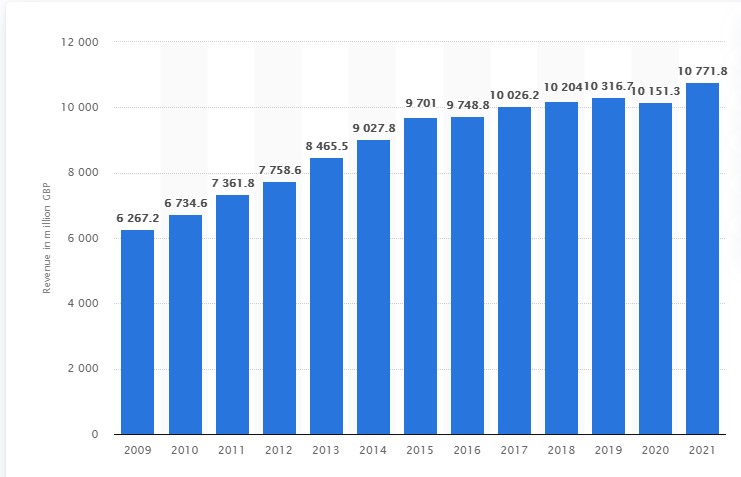
Omnichannel customer experience approach
In 2011 John Lewis reconstructed its entire customer experience approach with technological tools. Hiring British Airways ex-CIO Paul Cody was a huge step in that direction, as he redesigned the entire model so that all the channels (online, mobile, brick-and-mortar, call center) would work like clockwork. He connected the physical store with the digital, the online with the offline presence. He also updated the EPoS (electronic point of sale system) structure, which was the same since the 1990s, and reexamined the John Lewis supply chain strategy and ordering system.
Through these changes, the company was able to track, control, and know the status of every order across all methods. Moreover and more importantly, this provided the opportunity for the John Lewis omnichannel strategy to be implemented through data monitoring and management. Observing the habits of the customers gave John Lewis valuable information on what to expect in the long run. In particular, the brand was able to foresee both customer cross-channel behavior and the demands of the market.
Digital-First mentality
The John Lewis omnichannel strategy was once again ahead of its time when it anticipated the rise of eCommerce, even before the COVID-19 era. The pandemic only expedited the online experience and those few who saw it coming benefited significantly, John Lewis included. So far 20% of the Waitrose and 60% of the John Lewis purchases are made through digital means.
The company took under consideration the direction that consumer customs will take and the plan to invest in their online presence was a very strong strategic move. John Lewis Partnership Chairman, Sharon White, stated that the physical stores are an important part of the brand, but they will function as support for all things online.
Extended Click & Collect location strategy
It is not unusual for the brand’s loyal customers to place their orders online but pick them up physically. With that in mind, last July, the partnership collaborated with Co-op to improve the John Lewis distribution channels. The aim was to double the company’s network, making shopping more accessible and convenient for its customers.
The department store expanded the click-and-collect function to 500 branches of the Co-op, resulting in nearly 900 collect points across the UK. This expansion enabled the company to reach more of its existing customers while engaging new ones.
“Never knowingly undersold” motto
The famous John Lewis motto was first coined when Spedan Lewis took the Peter Jones company reins in 1925 and transferred it later to the entire brand. It referred to the store’s whole pricing philosophy, that John Lewis will never knowingly sell the same product at a higher price than its competitors. Therefore, they always promised competitive prices and permitted the customers to ask for a refund when a product was indeed more expensive.
The promise John Lewis made to its clients was later on embedded into the company’s positioning and promotion. By the 1980s the catchphrase appeared everywhere; on gift tokens, carrier bags, shop windows, vehicle liveries, and receipts. What started as a reminder of the company’s pricing policy, turned into an advertising strategy that, consequently, referred to its value and its service.
Business model and Customer Service
For almost 150 years, since Spedan Lewis came up with the partnership idea, the John Lewis group has functioned as a co-operative. This business model proved really important for the growth of the company since it inspires every employee to be personally involved and invested. The John Lewis community is based on the staff’s personal approach, and this structure is believed to reduce turnover and absenteeism.
Moreover, this unique co-ownership with elected board members and committees increases visibility across the business, ensures fairness, and improves the company’s overall service. The exemplar John Lewis customer service is a direct outcome of the company’s whole philosophy and it is the pillar of its success. The co-operative structure motivates the trained staff (namely partners) to go the extra mile and ensure customer satisfaction.
3 times when the John Lewis omnichannel strategy redefined customer experience in homeware retail
Lockdown was a new, not so pleasant, experience for most of us, but it also brought life to a lot of resourceful concepts. The John Lewis communication team came up with some very fitting ideas in such a distressing period, launching numerous innovative services & highlighting the brand’s omnichannel mentality and culture, just like Sephora did in the cosmetics, IKEA in the furniture, Screwfix in the hardware retail, and ASDA in the supermarket industry. Teleconferences are the new norm these days, but John Lewis found a way to make it fun and take it up a notch with its “Services and Experiences” series.
Example #1: John Lewis Online personal styling via Zoom

Last year, since non-essential stores were mostly closed, John Lewis found a very interesting way to stay relevant. The brand launched a new service for personal styling via Zoom with the help of in-store advisers. Customers had the opportunity to book a personalized online session with the stylist of their choice from the comfort of their home.
Completely free of charge and with no obligation to purchase anything at the end of the session, John Lewis offered its expertise to its audience. Of course, the service is still available, but since stores are open again, clients can also schedule an in-store appointment.
Example #2: John Lewis virtual or in-store advice appointments
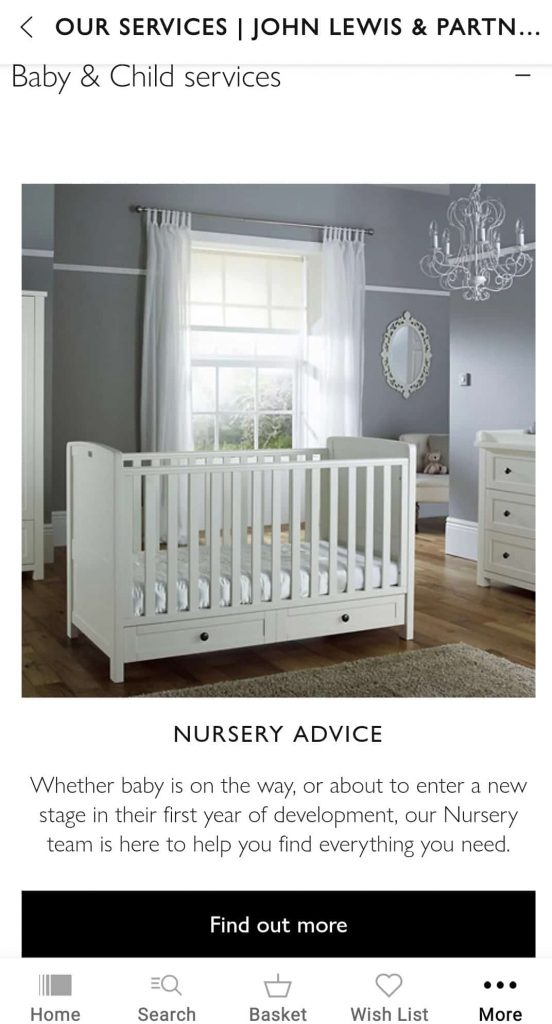
After the initial idea for personalized styling appointments, John Lewis expanded the possibilities and added more sections, with affordable fees. In-house beauty consultants, skilled technicians, or home designers are offering advice appointments for beauty, skincare, home design, and interior improvements. John Lewis even added sessions for new parents or parents-to-be with a lot of different subjects; for instance nursery decorations or product recommendations for babies and children.
Of course, these options are offered both online and in-store and refer to a variety of services. Some additional examples include kitchen, bedroom, and bathroom fittings, measuring up curtains, flooring, or carpets. Moreover, customers can book a session and design their own furnishings or access beauty guides and make-up tutorials. Last but not least, John Lewis provided eye tests with optometrists in selected locations.

Example #3: John Lewis exclusive virtual events

John Lewis rewards its loyal customers with exclusive online events. Loyal members can easily find these events, either on the website or in the mobile app, under the category “Our Experiences”. With a small fee, the members of the brand can attend cooking classes, wine tastings, cocktail classes, special festivals and so much more. More categories include, but are not limited to fashion events, gardening sessions, baby and child events, crafting.
Analyzing John Lewis’s eCommerce website
As mentioned above, this giant is one of the most digital-savvy retailers and their website is a very good example of that expertise. In this John Lewis case study, we analyzed four-page templates of their site to identify eCommerce best practices and mistakes you should avoid.
Analyzing John Lewis’s Home Page
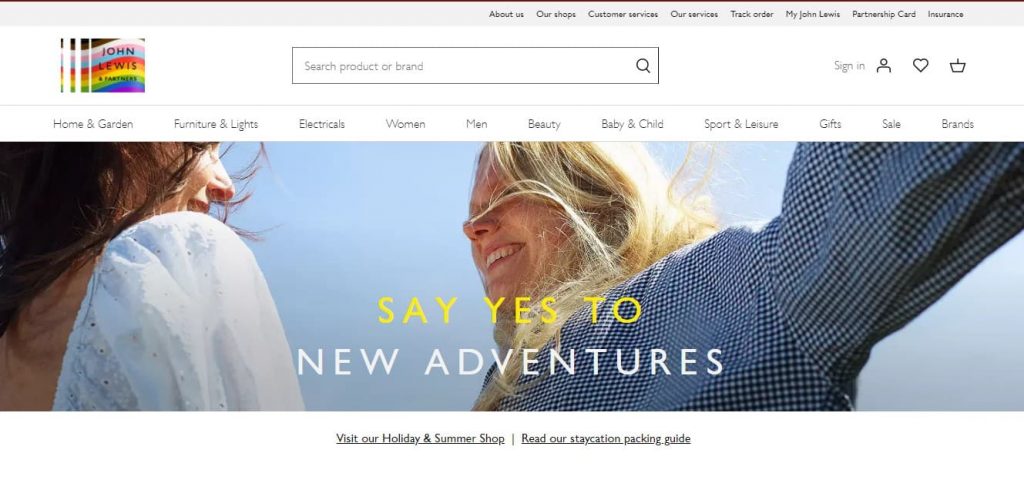
What We Liked
- Accessible and easy: Because John Lewis is a multi-department store, the customers can get easily confused. Thankfully, at the top of the page, each section is appropriately categorized to avoid unnecessary frustration. Scrolling down, visitors can also view seasonal content, product recommendations, the latest offers, and new brands.
- Smooth UX: Each category has an explicit drop-down menu so that everyone can find what they are looking for in a matter of seconds. Easy navigation is key.
- Minimalist visuals: Although the home page’s visuals are simple, they are eye-catchy and the customers can choose the section they are interested in with no trouble.
- Category-based architecture: Showcasing your top performing categories at your company’s home page is an eCommerce best practice since it helps in both conversions and SEO. John Lewis’s home page does this brilliantly
What We Didn’t
- Too discount-driven: Even during the sales period, focusing 100% on discounts and offers can dangerously limit your profit margins. We would recommend also featuring some “Shop the Look/Style” sections to increase Average Order Value (AOV).
- The home page is really long: One of John Lewis’s home page disadvantages is that it is incredibly long and social media icons are getting lost. Customers have to scroll all the way down before they can find the footer of the page. This element may be potentially problematic for a visitor who won’t be able to locate the necessary contact information.
B. Analyzing John Lewis’s Category Page
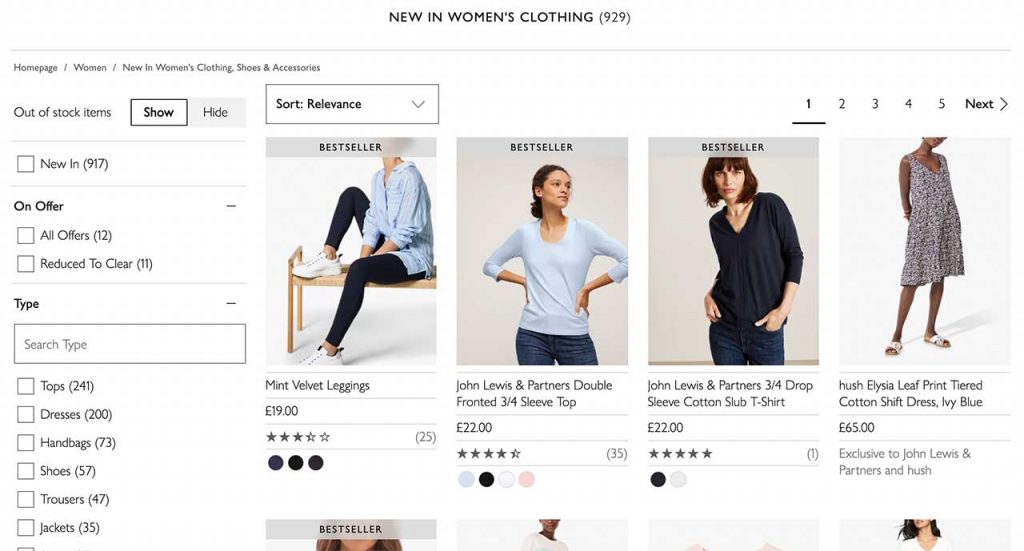
What We Liked
- Sticky Cart functionality: Old but gold, the sticky cart is still an effective recipe for success and this feature could not be missing from John Lewis’s website. Customers have the chance to be always updated on the status of their carts and easily proceed to the checkout page.
- Filter variety: Visitors can browse freely with a vast selection of filters on the left of the page to make their shopping experience easier and locate their favorite products. Scrolling down, shoppers can be informed about existing offers, explore popular brands and products, get inspired, or even schedule their own styling appointment.
- Quick view and quick-add-to-cart: Clicking on the “Quick View” button customers can effortlessly read all the important information about their preferred products without having to open multiple tabs. Similarly, they can add their purchases to their cart directly from the category page, making life a little easier.
What We Didn’t
- Overwhelming: In general, having many choices and dividing the products into categories is a good thing. Though at times it can be slightly distracting and complicated for new customers.
C. Analyzing John Lewis’s Product Page
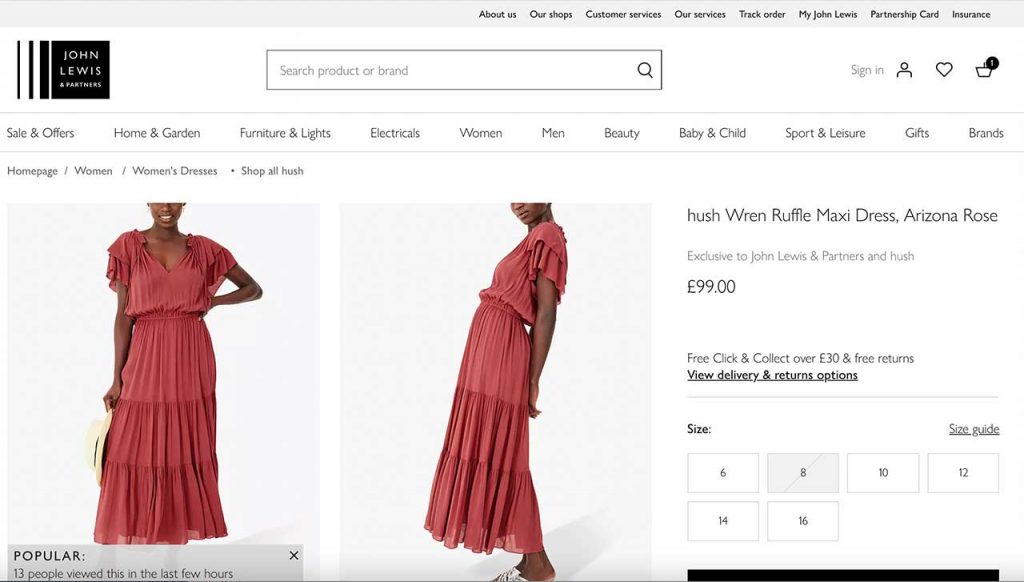
What We Liked
- Detailed product descriptions: John Lewis made sure to include all relevant information about each product on its designated page. This way customers can be fully aware of their purchase and make an informed decision
- Customer reviews: Reviews offer consumers a better understanding of what they are buying. Customer testimonials are a very good way for someone to decide whether a product will suit their needs or not.
- Style with it section: Great cross-selling widget to increase Average Order Value.
- Delivery and return options: John Lewis is famous for its delivery and returns service and this is highlighted on its product page as well. Customers feel safer when they have an ETA on their delivery and, of course, when they know that they can return the product if something goes wrong.
- Live Notifications: The “13 people viewed this in the last few hours” notification is a great way to create scarcity and increase the Add-to-Cart rate.
What We Didn’t
- Lack of sticky menu/cart: Adding a sticky upper menu and/or a sticky Add to Cart button could help increase mobile conversions, improve mobile UX and boost branding overall. (Extensive use of white and the lack of branding assets are confusing at the moment)
D. Analyzing John Lewis’s Checkout Process
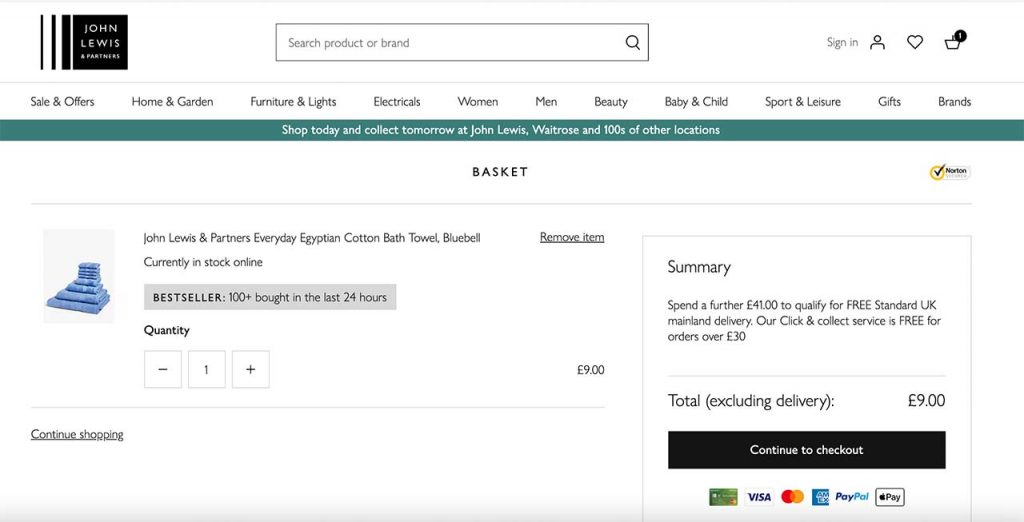
What We Liked
- Guest checkout: For someone that is not interested or not comfortable in creating an account, John Lewis provides a very subtle and classy option. Proceeding as a guest allows shoppers to fully take advantage of the brand’s commodities without allowing their personal information to be used in the future.
- Credible payment options: Besides the standard payment methods via Visa or Mastercard, customers can also complete their purchase using Paypal for safer transactions.
- Numerous click-and-collect store options: The John Lewis marketing strategy is all about accessibility. The extensive network provides a variety of nearby stores so that the buyers can choose which is closest to their location.
- Bestseller boxed notification: Nice tactic which creates more trust and validation for the user to move on to the checkout page and reduces cart abandonment
- Spend a further £XX.XX for free shipping: A nice tactic to increase Average Order Value (AoV)
What We Didn’t
- No international deliveries: Probably one of the most important downsizes, is that John Lewis does not have international shipping. This excludes customers outside the UK to enjoy the John Lewis quality. As a consequence, citizens outside the UK cannot subscribe to the John Lewis loyalty program either.
Interesting eCommerce tools that John Lewis uses
Using the buildwith tool we scanned the giant’s UK website and we highlighted the most impressive technologies spotted.
- Omniture SiteCatalyst: A very successful Web analytics system with the Adobe signature, SiteCatalyst is the go-to platform for marketers.
- Bazaarvoice: A software for user-generated content and a lot of functionalities.
- Hotjar: Maybe the world’s most famous screen recording & heat maps tool. Great value at a reasonable price for a very useful service.
- Monetate: Customer experience optimization software, ideal for personalized digital marketing solutions.
Impressive John Lewis facts you may not know
To get a glimpse of what is happening “behind the scenes”, we present you with some very interesting facts about the John Lewis empire.
- With the implementation of the “digital-first” strategy, John Lewis plans to repurpose redundant physical stores by turning some of them into affordable housing.
- John Lewis has a written constitution establishing the principles, system, and rules of the company.
- The John Lewis Christmas ads have become a cultural phenomenon in the UK and are anticipated every year. Specifically, the Christmas ad with Buster the Boxer holds the record of the fastest viral success with 28.5 million views in 24 hours.
- In 2007 the John Lewis & Partners Reading was awarded a Royal Warrant from Queen Elizabeth II. Accordingly, in 2008 the Oxford Street store was awarded the same Royal Warrant as “suppliers of haberdashery and household goods”.
Latest company news of John Lewis
- John Lewis expands furniture rental service following successful trial – June 2021
- John Lewis slams UK education system and offers staff literacy lessons – June 2021
- John Lewis expands online fashion offering with 100 new brands – June 2021
Omnichannel is behind every success story
The John Lewis omnichannel strategy has a proven record of success and that is demonstrated through 156 years of experience. Undoubtedly, this was the result of a consistent, brilliant, passionate, and exceptionally executed strategy. The company’s business game plan was also successfully replicated online, adjusting to the difficulties of a pandemic and the fast-changing environment of online retail. The competition is strong and surely those who do not adapt in time are destined to perish.
While the John Lewis marketing & business strategy is really solid, there is always room for improvement. As the digital landscape continues to set new trends, customers are getting easily diverted by the plethora of information. As such, corporations have to stand out, and the omnichannel approach is a must since targeted advertising and personalization are here to stay. We at ContactPigeon, with advanced customer engagement and marketing automation features, bring retailers one step closer to modernization. You can book a free marketing automation consultation with us and align your marketing narrative with the signs of the times.

Let’s Help You Scale Up
Spending time on Linkedin? Follow us and get notified of our thought-leadership content:


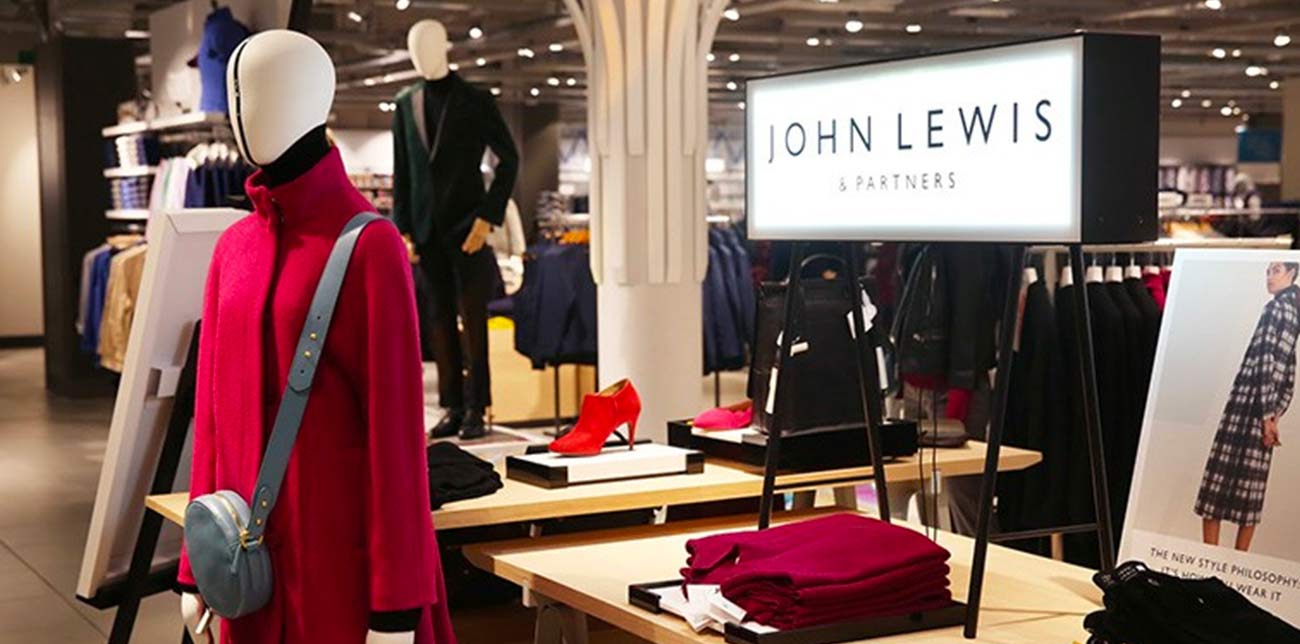

![Benchmarking Growth Strategies of Top Fashion Retailers [Study]](https://blog.contactpigeon.com/wp-content/uploads/2025/11/top-fashion-retailers.jpg)